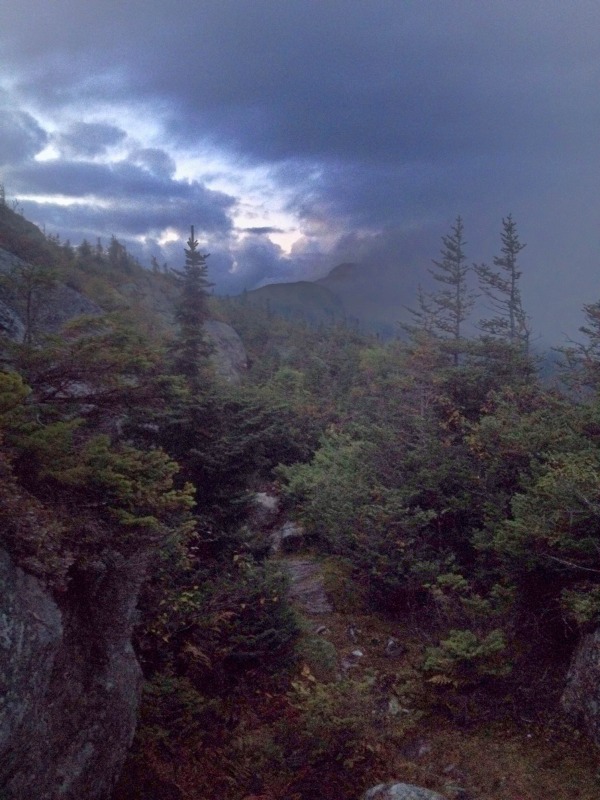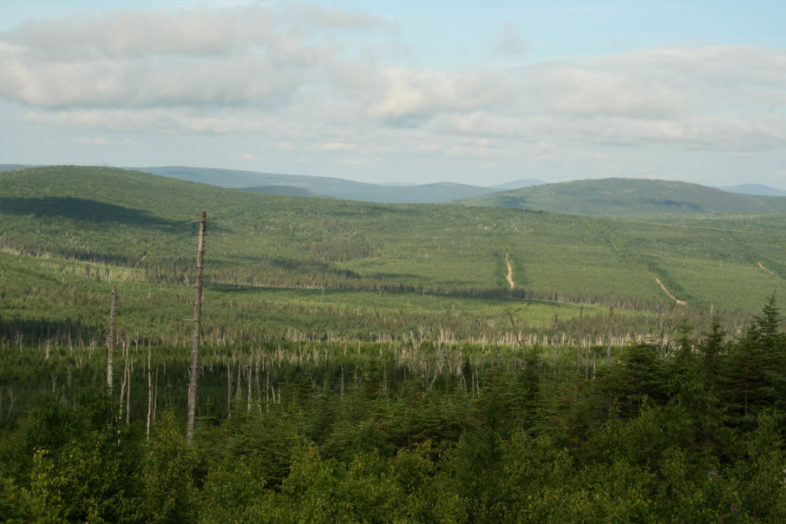Most of us think about Bicknell’s Thrush as a bird of the cold, wet, and stunted forests of the highest mountains. And, in the United States, this is a pretty accurate picture.

Classic Bicknell’s Thrush habitat in the United States: Dusk in the Clouds on Mt. Mansfield, VT. / K.P. McFarland
Ask a New Brunswicker, though, and you’re likely to get a somewhat different answer.

Bicknell’s Thrush habitat in New Brunswick. Photo by Dr. Emily McKinnon.
It turns out that in New Brunswick, as well as Quebec and Nova Scotia, Bicknell’s Thrush is also very much a bird of young, regenerating forest of the kind that regrows after clearcutting, wildfire, or extensive insect damage. Indeed, Henri Ouellet, the scientist who made the case for recognizing Bicknell’s Thrush as a distinct species, argued that Bicknell’s Thrush were probably more abundant in low-elevation, regenerating forests than they were in the spruce-fir forests of our mountaintops. Like forests at high elevation that are chronically disturbed by weather, young forests at lower elevations are short-statured and extremely dense.
Surprisingly, we have very little evidence that Bicknell’s Thrush nest in regenerating forest stands in the United States, despite extensive swaths of young forest in western Maine and northern New Hampshire created by commercial timber harvest. Initial efforts to document the distribution of Bicknell’s Thrush in New York and New England did not uncover the species in areas of Maine that had been recently clearcut, and no further systematic surveys have since been conducted. Anecdotal reports trickle in of Bicknell’s Thrush singing from clearcuts in Maine, but solid documentation that these young forests are habitable by Bicknell’s Thrush are lacking.
Getting to the bottom of this question is important. First, it would give us a better understanding of the distribution and ecology of Bicknell’s Thrush. Second, and perhaps more importantly, it could help us design better conservation measures for the species. For example, it might help us figure out how to better incorporate Bicknell’s Thrush into forest-management plans, something that has been done successfully in Canada.
This summer, we will start trying to answer this question. Do Bicknell’s Thrush nest in young forests at lower elevations here in the United States? We’ll figure this out by surveying young forest stands that are in the process of regenerating after logging. This summer we will focus on a few townships in western Maine, but in years to come we plan to expand west into New Hampshire and further north into the border country of western Maine. In order to increase the number of places that we can survey this summer, we’ll use the same automated recording devices that we’ve used on Mount Mansfield.
A preliminary answer should emerge in the next few months after we’ve done battle with logging roads, black flies, and probably a mosquito or two. Stay tuned…

Interesting, but I’m surprised there was NO mention here of wintering habitat / range. It’s vital to protect that winter habitat, in Dominican Republic, for example, because you can make available all the habitat and protections in their breeding territory, and if there aren’t enough birds to fill it, the suitable habitat is of no use.
saw 3 Bicknell’s on May 31 from the Toll Road, above 3,600 feet.
Heard several more — we think 6 individuals.